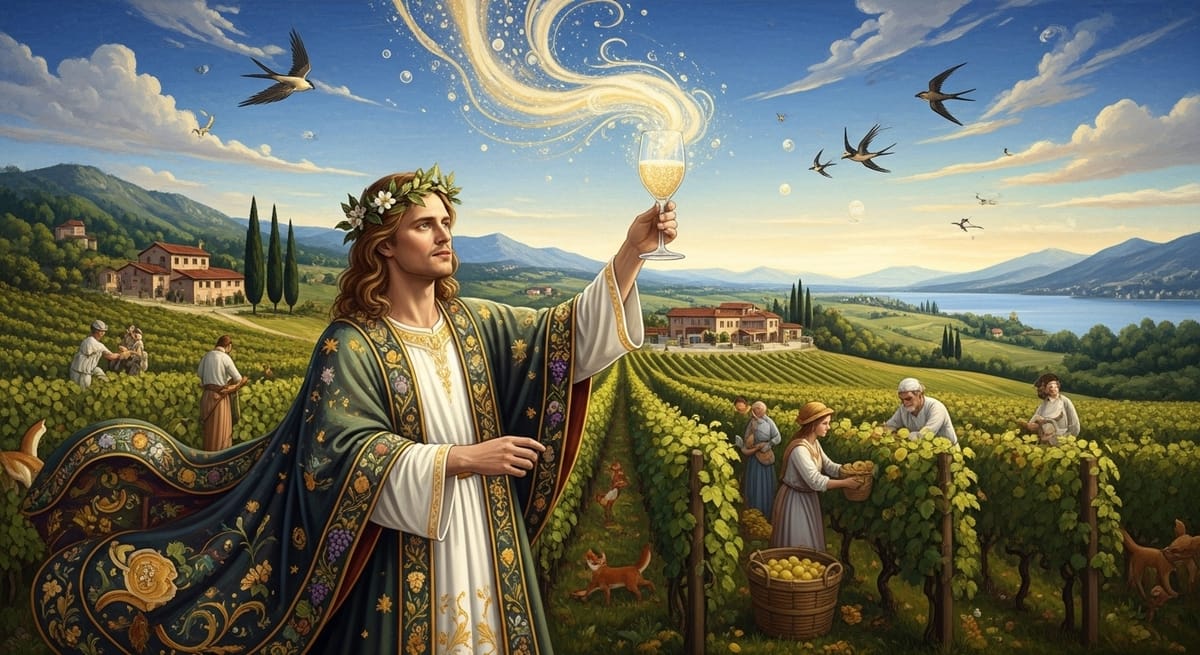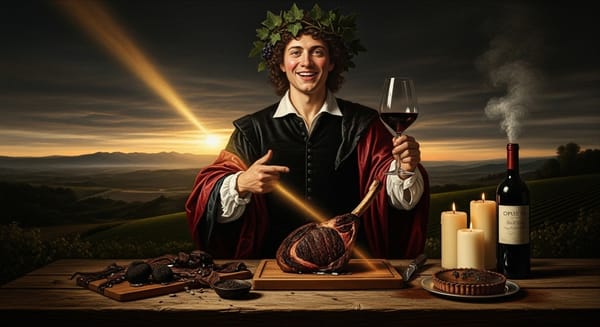The Forest That Learned to Sing: The Story of Ca’ del Bosco
Explore the story of Ca’ del Bosco — how Maurizio Zanella turned a Lombard forest into one of the world’s top sparkling wine estates. From innovation to iconic cuvées, discover how Franciacorta found its voice.

How one dreamer turned a Lombard hillside into a temple of bubbles — and transformed Franciacorta into Italy’s sparkling soul.
I. Prologue: Where the Forest Dreamed of Wine
Some vineyards are born of lineage. Some from empire. And some — the rarest, the most fascinating — are born from imagination.
Ca’ del Bosco, the crown jewel of Franciacorta, belongs to that final, sacred category. It is a place where the old rhythms of nature were reimagined, where tradition met innovation head-on, and where Italian sparkling wine stopped imitating Champagne and began speaking in its own voice.
I, Liber, god of wine and metamorphosis, have seen many revolutions. But few have unfolded with such grace, daring, and precision as the one that began in a forest in the hills of Lombardy.
II. The Birth of a Visionary
Our story begins not in the Middle Ages or the Renaissance, but in the second half of the 20th century — a time when Italy’s fine wine revolution was still gathering momentum. In 1964, a young man named Maurizio Zanella, barely out of adolescence, stepped onto a small parcel of land near Erbusco in the heart of Franciacorta.
It was a wild place — a dense, tangled bosco (forest) dotted with chestnut and oak. But where others saw wilderness, Maurizio saw possibility. Inspired by visits to Champagne and by a new generation of Italian vintners who believed their homeland could rival the world’s best, he decided to build a sparkling wine estate from the ground up.
He named it Ca’ del Bosco — literally, “house in the woods” — a nod to its humble origins. But the ambition was anything but modest.
III. Franciacorta Before the Revolution
At that time, Franciacorta was a quiet corner of Lombardy, known mostly for rustic still wines and bulk production. The region had a long viticultural history — the Romans had praised its wines, and monasteries had cultivated vines here for centuries — but it lacked global recognition.
Maurizio believed that could change. The region’s unique terroir — rolling hills of glacial moraine soils, tempered by breezes from nearby Lake Iseo — was ideal for producing wines of finesse and complexity. And the diurnal shifts between warm days and cool nights preserved the acidity essential for high-quality sparkling wine.
What was missing was vision, precision, and patience. Maurizio set out to provide all three.
IV. Building a Temple of Bubbles
From the very beginning, Ca’ del Bosco operated more like a grand cru Champagne house than a traditional Italian winery. Zanella invested heavily in technology, precision viticulture, and meticulous cellar practices.
- Vineyard Philosophy: Old, massal-selected vines planted at high density, hand-harvested, and farmed with minimal intervention.
- Grape Varieties: Classic Champagne trio — Chardonnay, Pinot Nero, and Pinot Bianco — reinterpreted through Franciacorta’s terroir.
- Innovations:
- A groundbreaking “berry spa” system that gently washes grapes before pressing, ensuring unmatched purity.
- Advanced gravity-flow cellars to preserve delicacy and avoid oxidation.
- Long lees aging and low dosage, producing wines of remarkable texture and depth.
Maurizio’s obsessive attention to detail paid off. In just a few decades, Ca’ del Bosco went from unknown upstart to the undisputed benchmark of Italian sparkling wine — the reference point by which all others are measured.
V. Franciacorta Ascends
In 1995, Franciacorta achieved DOCG status, the highest designation in Italian wine law — the first and still one of the only sparkling wine appellations to do so. Ca’ del Bosco was at the forefront of that achievement, shaping the region’s identity and global reputation.
The wines spoke with unmistakable authority. The Cuvée Prestige became a benchmark for precision and elegance — creamy and refined, with notes of orchard fruit, brioche, and white flowers. The Vintage Collection Satèn showed the softer, silkier side of Franciacorta. And the Annamaria Clementi, named after Maurizio’s mother, emerged as a true icon — a tête de cuvée capable of rivaling the best wines of Champagne for longevity, depth, and grace.
But perhaps most importantly, Ca’ del Bosco gave Franciacorta its own voice. These wines were not Champagne imitations; they were distinct, expressive, profoundly Italian — wines of sunshine, minerality, and Mediterranean soul.
VI. A New Era: Innovation Without End
Even as it achieved global recognition, Ca’ del Bosco never stopped evolving. The estate embraced organic and sustainable farming, expanded its vineyard holdings, and continued to refine its cellar practices. Cutting-edge art installations were added to the property, transforming the estate into a destination where wine, nature, and creativity converge.
Maurizio himself became one of the most influential figures in modern Italian wine — a passionate advocate for Franciacorta and a visionary who proved that Italy could produce sparkling wines of world-class quality.
VII. Liber’s Reflection: The Forest That Found Its Voice
I, Liber, have watched many vineyards chase greatness by emulating their neighbors. But Ca’ del Bosco never chased — it created. It took a landscape once forgotten and turned it into a stage for innovation. It transformed a humble forest into a cathedral of light and bubbles.
And in doing so, it redefined what Italian wine could be.
To taste Ca’ del Bosco is to taste possibility itself: the crisp minerality of glacial soils, the golden generosity of Lombard sunlight, the disciplined hand of a visionary, and the joyous spirit of a region that found its voice.
It is a wine that dances between past and future — born of Champagne’s precision, shaped by Italy’s exuberance, and blessed by the gods of transformation. 🍾
✨ Final Benediction
Some estates follow the path others paved.
Ca’ del Bosco cut a road through the forest — and the world followed.





